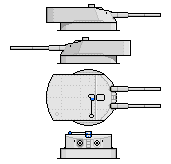Difference between revisions of "28 cm/45 (11") SK L/45"
Rundrewrun (talk | contribs) (→History) |
|||
| Line 8: | Line 8: | ||
Constructed of A tube, two layers of hoops and a jacket. Used the Krupp horizontal sliding wedge breech block. | Constructed of A tube, two layers of hoops and a jacket. Used the Krupp horizontal sliding wedge breech block. | ||
| − | All German 28 cm guns had an actual bore diameter of 28.3 cm (11.1")." | + | All German 28 cm guns had an actual bore diameter of 28.3 cm (11.1")." <ref>http://www.navweaps.com/Weapons/WNGER_11-45_skc07.php</ref> |
{| class="wikitable" | {| class="wikitable" | ||
| Line 53: | Line 53: | ||
== See also == | == See also == | ||
| − | + | ||
| + | <references /> | ||
[[Category:Components]] | [[Category:Components]] | ||
[[Category:German Navy components]] | [[Category:German Navy components]] | ||
Revision as of 21:36, 16 March 2018
History
"These guns were used to arm Germany's first "Dreadnought" type battleships and battlecruisers. The battlecruiser Von der Tann used these weapons to sink HMS Indefatigable at the Battle of Jutland (Skagerrak).
During World War II these guns were used only as coastal artillery. They were then supplied with a lighter shell with a larger propellant charge for increased range.
Constructed of A tube, two layers of hoops and a jacket. Used the Krupp horizontal sliding wedge breech block.
All German 28 cm guns had an actual bore diameter of 28.3 cm (11.1")." [1]
| Designation | 28 cm/45 (11") SK L/45 |
|---|---|
| Date of Design | 1907 |
| Date of Service | 1909 |
| Gun Weight | About 39,800 kg |
| Gun Length Overall | 12.735 m |
| Bore Length | 12.006 m |
| Rifling Length | 9.699 m |
| Grooves | 2.8 mm D x 6.92 mm W |
| Chamber Volume | 150 dm^3 |
| Rate of Fire | 3 rounds per minute |
Used on
Affiliated systems
Part description
Description that clarifies or expands on what somebody using the part should know before using it.
